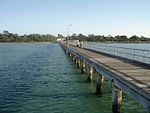McCrae, Victoria
McCrae is a Melbourne suburb on the Mornington Peninsula, Victoria, Australia. Its local government area is the Shire of Mornington Peninsula. McCrae is known for the McCrae Lighthouse. No longer an operating lighthouse, it marked the turning point for shipping in the main navigational channels between Port Phillip Heads and Melbourne. Recently a new shopping center called McCrae Plaza opened and it included a Bilo Supermarket, which later became a Coles Supermarket. The area was named after the McCrae family who were the first Europeans to settle the area. The homestead that they built, McCrae Homestead is a National Trust property that is open to the public. In March 2011, McCrae Yacht Club hosted the Victorian Championship regattas for the A-Class Catamarans. They sailed seven races from 12 to 14 March.
Excerpt from the Wikipedia article McCrae, Victoria (License: CC BY-SA 3.0, Authors).McCrae, Victoria
Point Nepean Road, Melbourne McCrae
Geographical coordinates (GPS) Address Nearby Places Show on map
Geographical coordinates (GPS)
| Latitude | Longitude |
|---|---|
| N -38.351 ° | E 144.922 ° |
Address
Point Nepean Road
Point Nepean Road
3938 Melbourne, McCrae
Victoria, Australia
Open on Google Maps





